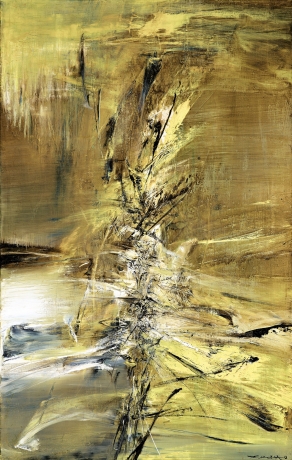PROVENANCE:
Kootz Gallery, New York
Private collection, Asia
This painting is to be sold with a certificate of authenticity signed by the artist.
Catalogue Note:
This lot, Zao Wou-ki's "19.7.63", was also once on sale in the Kootz Gallery when the art dealer's professionalism and discriminating eye were already widely known. Unlike most other gallery owners, Kootz encouraged the young Zao to follow his inspiration and paint whatever he liked, without regard for size or format. This shows in Zao's output of that time, as he began to develop his typical unrestrained and dynamic style. These are the bold, sweeping bushstrokes that first attract the observer's eye in "19.7.63", and at a closer look one finds that the interconnected powerful lines that dominate the picture are very reminiscent of traditional Chinese calligraphy. Zao originally came from old literati family, and from his early childhood he was a great admirer of the painting and calligraphy of Song Dynasty literati artist Mi Fu (1051-1107), whom he considered as the most outstanding calligrapher in Chinese history. Another painter he held in high esteem was Fan Kuan (c. 990-1030), particularly admiring his conception of nature. In Zao's view, the use of space in both Mi's calligraphy and Fan's landscape paintings has a lot in common with the work of Paul Cézanne. As for Zao's own work, French art critic Jean Leymarie describes it as "combining the poignancy of calligraphy with the flavor of painting."
Chinese-born painter Hsiao Chin once praised Zao as "the first painter to introduce the aesthetics of traditional Chinese art into the world of international painting". Hsiao also feels that painters such as America's Marc Tobey and Franz Kline, or France's Georges Mathieu, as well as numerous artists involved with action painting and non-objective representation, all derived much inspiration from Chinese and Japanese calligraphy. He even goes so far as to claim that much of the evolution of abstract painting between 1950 and 1960 was determined by the influx of calligraphic concepts from China and Japan, and that Zao Wou-ki was the epitome of this new direction in art. (cf. Yuan Teh-hsing, ed., Zao Wou-ki, Taipei: Yuan Cheng Publishers, 1980, p. 7)
In his book Masters of Chinese Painting: Zao Wou-ki, renowned Taiwanese art historian Hsiao Chong-ray analyses the characteristics of Zao's style in the 1960s: "Brown and yellow tones dominate in Zao's work from the 60s, colors emanating a bronze-golden glow that are applied across the canvas with vigorous abandon to form lines and shapes of both refined subtlety and keen intensity - filamentary and just a touch frantic in quality. These lines are assembled in a free fashion without any concern for motif or preconceived notions. Zao shakes off all formal restraints and follows his inner vision, thereby revealing a profound and rich imagination that fills his compositions with primal energy and creates a world where the most dazzling beauty bursts from a wasteland." Undoubtedly, these words also capture many of the qualities of "19.7.63".
During the 1950s, Zao discovered the visual appeal and formative beauty of Chinese oracle bone and bronze inscriptions. There is some symbolism in the golden hues of bronze, suggesting the sacred, classical and cultured, as well as an atmosphere of bliss and prosperity. But in Zao's work, things are more complex than that: while the immediately appreciable aesthetic charm of his paintings speaks of the artist's success in sublimating his inner life, the somewhat frenzied fibrous lines responsible for much of the dynamic impetus also reveal a darker side dominated by ravaging turmoil and gloomy inner conflict. Some of this may be explained as an indirect expression of Zao's worries about the health of his wife, May. The pressure and melancholy he probably felt because of her sickness can be guessed from the way Zao, as he himself explains, frequently uses the palette knife to squeeze the paint firmly into the canvas, as if this would create an even more plastic effect of depth. But mostly, so the artist, the uninhibited application of color in sweeping strokes and spattered dabs, overlapping and chaotic, makes him feel calm and at ease. As he writes in his autobiography, "The fierce and intense, the clamorous and passionate have always attracted me much more than the quiet and the stationary. How to conquer space, how to shape and enliven it is a problem that is constantly on my mind." In the 1960s, for Zao painting meant meeting new challenges. It was a struggle to find his voice, his way of getting "inside space" and exploring his emotions. Since his 60s paintings are particularly brimming with vitality and creative energy, it is not surprising that Western art critics and dealers find Zao's output from this period among the most impressive in his entire oeuvre. It was a time of departure for the artist, of embarking on the pursuit of his ideals without looking back. This new hope and determination is communicated to the observer with almost painful poignancy, uplifting to heart and mind.
